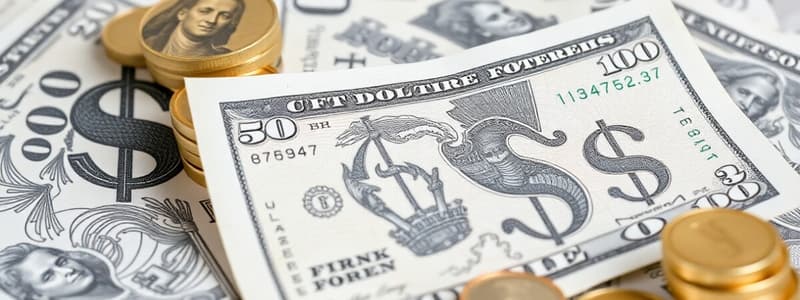Podcast
Questions and Answers
Which of the following is NOT a primary function of money?
Which of the following is NOT a primary function of money?
- A tool for direct barter (correct)
- A unit of account
- A store of value
- A medium of exchange
The possibility of bartering relies on each party necessarily wanting what the other party offers, which can complicate transactions.
The possibility of bartering relies on each party necessarily wanting what the other party offers, which can complicate transactions.
True (A)
Which of the following is the MOST accurate description of the historical use of precious metals as currency?
Which of the following is the MOST accurate description of the historical use of precious metals as currency?
- Precious metals were exclusively used for large international transactions.
- Precious metals were rarely used due to their scarcity and difficulty in handling.
- Precious metals were often used but could be subject to debasement by rulers. (correct)
- Precious metals were consistently used in their pure form without any modifications.
What action did Erik Klipping of Denmark undertake that led to his nickname?
What action did Erik Klipping of Denmark undertake that led to his nickname?
In what historical period and region did paper money first appear in the West?
In what historical period and region did paper money first appear in the West?
Fiat money derives its value primarily from being redeemable for a fixed quantity of a commodity like gold or silver.
Fiat money derives its value primarily from being redeemable for a fixed quantity of a commodity like gold or silver.
A central bank's role includes all of the following EXCEPT:
A central bank's role includes all of the following EXCEPT:
Match the following money supply aggregates with their descriptions:
Match the following money supply aggregates with their descriptions:
How do banks create money in a fractional reserve banking system?
How do banks create money in a fractional reserve banking system?
Which of the following represents a key challenge associated with alternative currencies like Bitcoin?
Which of the following represents a key challenge associated with alternative currencies like Bitcoin?
The quantity theory of money states that changes in the money supply have no impact on the price level in the long run.
The quantity theory of money states that changes in the money supply have no impact on the price level in the long run.
According to monetarists, what is the primary cause of inflation?
According to monetarists, what is the primary cause of inflation?
What is the term used to describe extremely high inflation rates, often exceeding 50% per month?
What is the term used to describe extremely high inflation rates, often exceeding 50% per month?
Match the following historical events with the type of monetary policy that was in effect:
Match the following historical events with the type of monetary policy that was in effect:
What are 'shoe-leather costs' associated with inflation?
What are 'shoe-leather costs' associated with inflation?
Which of the following describes how unpredictable inflation primarily impacts relative prices?
Which of the following describes how unpredictable inflation primarily impacts relative prices?
Indexing all contracts and the tax system completely eliminates the potential problems caused by inflation.
Indexing all contracts and the tax system completely eliminates the potential problems caused by inflation.
Which of the following is the primary role of central banks in relation to inflation?
Which of the following is the primary role of central banks in relation to inflation?
An independent central bank is more susceptible to political pressure, making it more likely to implement unpopular but necessary economic measures.
An independent central bank is more susceptible to political pressure, making it more likely to implement unpopular but necessary economic measures.
What is seignorage?
What is seignorage?
Which of the following is offered as a reason that Bitcoin is not a reliable base for an economy?
Which of the following is offered as a reason that Bitcoin is not a reliable base for an economy?
In the context of central banking, the term ______ refers to the situation where a central bank lends money to the government.
In the context of central banking, the term ______ refers to the situation where a central bank lends money to the government.
Which of the following describes a key characteristic of private electronic currencies?
Which of the following describes a key characteristic of private electronic currencies?
It is not possible to apply monetary to Bitcoin.
It is not possible to apply monetary to Bitcoin.
What does it mean when it is reported that 'Norge utreder' in the context of electronic central bank currency?
What does it mean when it is reported that 'Norge utreder' in the context of electronic central bank currency?
Flashcards
What are the functions of money?
What are the functions of money?
Serves as a medium of exchange, unit of account, and store of value.
How did money enable division of labor?
How did money enable division of labor?
Facilitates specialization by eliminating the need for a 'double coincidence of wants'.
What is commodity money?
What is commodity money?
Goods with intrinsic value, like precious metals.
What does 'Preget mynt' mean?
What does 'Preget mynt' mean?
Signup and view all the flashcards
When did Sedler (bank notes) appear?
When did Sedler (bank notes) appear?
Signup and view all the flashcards
What is fiat money?
What is fiat money?
Signup and view all the flashcards
Who controls the current monetary system?
Who controls the current monetary system?
Signup and view all the flashcards
What is M0?
What is M0?
Signup and view all the flashcards
What is M3?
What is M3?
Signup and view all the flashcards
How do banks create money?
How do banks create money?
Signup and view all the flashcards
What is Bitcoin?
What is Bitcoin?
Signup and view all the flashcards
Key assumption of Quantity Theory of Money?
Key assumption of Quantity Theory of Money?
Signup and view all the flashcards
What does Monetarism Say?
What does Monetarism Say?
Signup and view all the flashcards
What is Hyperinflation?
What is Hyperinflation?
Signup and view all the flashcards
What are the cost of inflation?
What are the cost of inflation?
Signup and view all the flashcards
What's the role of central banks?
What's the role of central banks?
Signup and view all the flashcards
What is seignorage?
What is seignorage?
Signup and view all the flashcards
How is trust created with Bitcoin?
How is trust created with Bitcoin?
Signup and view all the flashcards
Study Notes
The Function of Money
- Medium of exchange to facilitate trade
- Unit of Account, providing a standard measure of value
- Store of Value, allowing wealth to be preserved over time
Money Enabled Division of Labor
- Bartering can lead to very complicated exchange patterns as the seller does not necessarily require what the buyer has
- Money enables the division of labor and urbanization
- Money can preserve wealth and may lead to larger income disparities and power imbalances
- Accumulation makes investments more feasible
A Brief Monetary History: Money with Intrinsic Value
- Money can be just another commodity, but it has a high value relative to its weight
- Noble metals are often used as money, but also other materials in places without precious metals
- Early Vikings broke pieces off silver bracelets that were used as currency
Minted Coins
- The state authorizes a specific composition/mix of metals when minting coins
- Kings were able to cheat, Erik Clipping of Denmark possibly got his name because of "clipping" coins in the 1200s
- Coinage dates back to approximately 500 BC in Lydia where Croesus was king
- Coinage may have been an essential symbol of power, such as in Norway (1200s), where there was conflict between the king and the archbishop regarding coinage
Banknotes
- Banknotes appeared in the West during the Renaissance in Italy, where gold stayed put and banknotes circulated as proof of ownership
- Marco Polo saw banknotes in China
- Central bank notes date back to the 1600s
First Norwegian Banknotes
- The first private Norwegian banknotes ended poorly
- Jørgen Thormøhlen issued notes in 1695/1696
Fiat Money
- Fiat money: Banknotes are no longer a claim on a commodity
- Norway's right to redeem banknotes was finally abolished in 1931, with indirect redemption via the dollar continuing until 1973
- The state guarantees the monetary system, but undermining it by printing vast sums of banknotes
- More banknotes chasing the same money causes inflation that undermines the value of money
Today's System
- Central banks control the system, issuing banknotes and coins
- Monetary systems are now based on trust, with a law on legal tender
- Banks are involved in the "creation of money" and must be controlled
- Different monetary concepts: M0 – M1 – M2 – M3...
- The path is towards electronic money
Narrow Money
- M0 is base money, central bank money
- Banknotes and coins in circulation
- Private banks' deposits in accounts within Norway's central bank
- M0 can also be electronic money
Broad Money
- M3 is the holding of the money-holding sector
- Includes Banknotes and coins
- In addition to deposits in transaction accounts
- Deposits with a brief notice period
- Banksertifikater, etc.
- Progressing from M1 to M2 to M3, the money supply gets broader while M0 is different
The Role of Banks
- Banks create money electronically
- When A borrows money from a bank, the bank creates electronic money and puts it into A's account, without needing deposits from anyone else
- Banks must have money available when people want to withdraw funds and the government imposes restrictions in the form of capital requirements
- Banks operate within strict constraints, and their profit-making abilities are limited
Alternative Money
- Ideologically motivated desire for monetary systems outside the control of regulators and banks
- Electronic money can also be central bank money that is government controlled
- Is there a gold standard with Bitcoin?
- In the past, such systems have been tested before
- Supply/demand can cause huge price fluctuations on the gold/bitcoin market
- Bitcoin is popular among murderers and drug dealers
- Control over the monetary system involves motives beyond monetary policy
Money and Inflation: The Quantity Theory
- M · V = P · Y
Monetarism (Milton Friedman)
- Monetarism is based on the quantity theory of money
- Inflation is a monetary phenomenon
- Inflation can be tamed with constant money supply growth, regardless of what drives wage-price spirals
- It is a precursor to inflation management
Hyperinflation
- Germany in the 1920s
- Norway around 1814
- Many events in developing nations such as Zimbabwe
- Stemmed from the government's hesitancy to finance the budget through taxation, opting instead for printing money
Costs of Inflation
- Money performs more poorly in its three functions when inflation is high or variable
- Relative prices become less clear, and market economies function more poorly
- Lack of indexation in contracts and tax systems can lead to significant changes in income distribution, particularly in the short term
- With prices going up and wages not keeping pace
- A solution may be full indexation, but it could cause hyperinflation
Central Banks and Inflation Targets
- Central banks have existed since the 1600s and oversee and support the banking system while loaning money to the government
- They stabilize the value of money, inflation, and the economy
- Central banks are becoming more independent of the government and can implement unpopular policies, and can also avoid contributing to poor economic management
- This may be a democratic issue
Seignorage
- Seignorage is the profit from circulating money
Back to Bitcoin
- Trust between the parties creates the blockchain in the system, not the reputation of the governments/central banks
- Seignorage is destroyed to a large extent in the electricity costs and labor costs
- It gives the system confidence, however, it is extremely wasteful
- Ultimately bitcoin is constant in its supply meaning no monetary policy is possible, however it is vulnerable to larger fluctuations in demand after the currency
- The price of Bitcoin fluctuates greatly, similar to gold
Many Types of Private Electronic Money
- Nobody central issues Bitcoin to receive seignorage
- Bitcoin can be branched out
- In a never-ending landscape, there are electronic types that could be created
- Ethereum is the most prominent competitor
- A search is underway to seek electronic funds that are easier to work with
- Transactions that require less energy
- What about electronic central bank funds? The repercussions on banking systems?
- China experiments while Norway evaluates
Studying That Suits You
Use AI to generate personalized quizzes and flashcards to suit your learning preferences.



